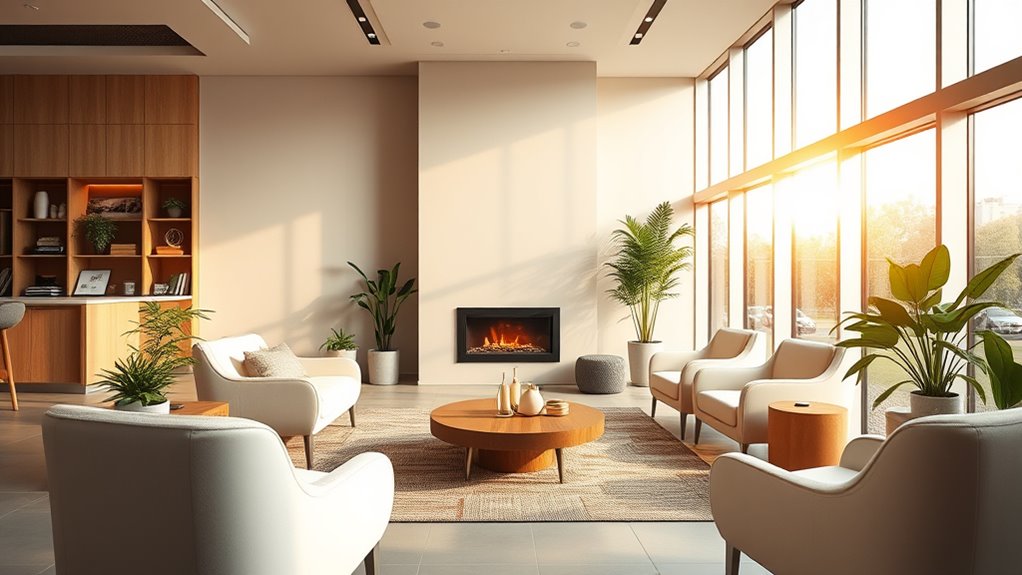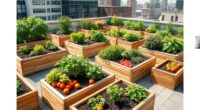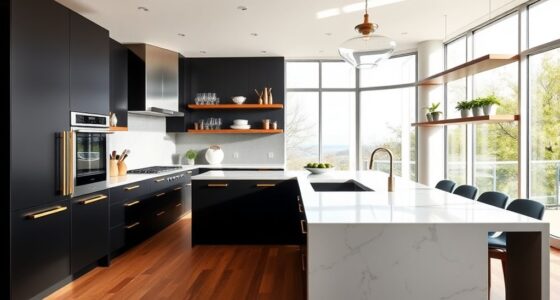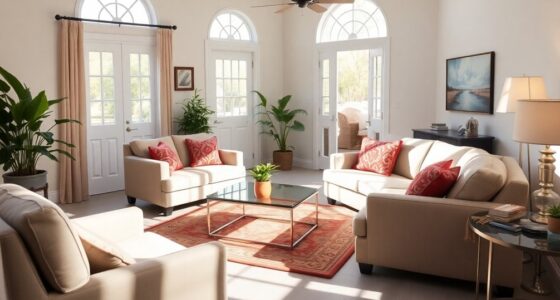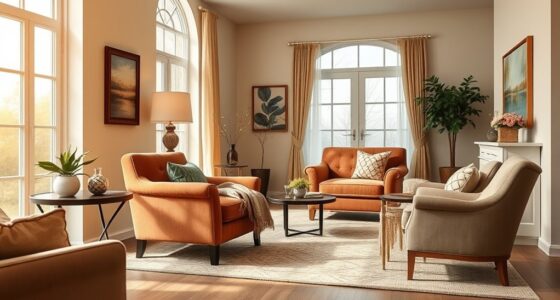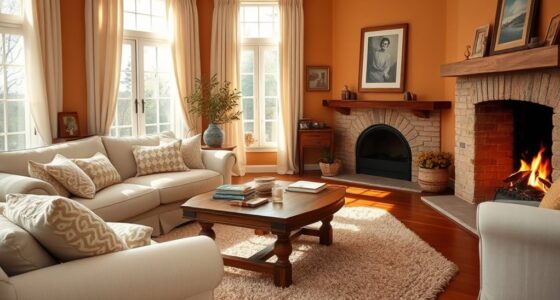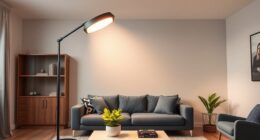In 2025, senior living design trends focus on seamlessly integrating smart technology with outdoor gardens to enhance safety, independence, and well-being. You’ll see intuitive indoor systems that control lighting, temperature, and security, making daily life easier. Outdoor spaces are designed with accessibility and natural beauty in mind, encouraging activity and socialization. These thoughtful features foster vibrant, secure environments that support both physical and emotional health. Explore more to discover how these innovations transform senior living experiences.
Key Takeaways
- Integration of smart home technology to enhance safety, independence, and seamless control of environment features.
- Emphasis on outdoor gardens designed for accessibility, relaxation, and promoting physical activity.
- Seamless indoor-outdoor environments with automated lighting and sensor systems for safety and ambiance.
- Focus on safety and accessibility through automation, smooth pathways, and adaptive design elements.
- Combining natural elements with innovative tech to foster active, engaging, and holistic senior living spaces.
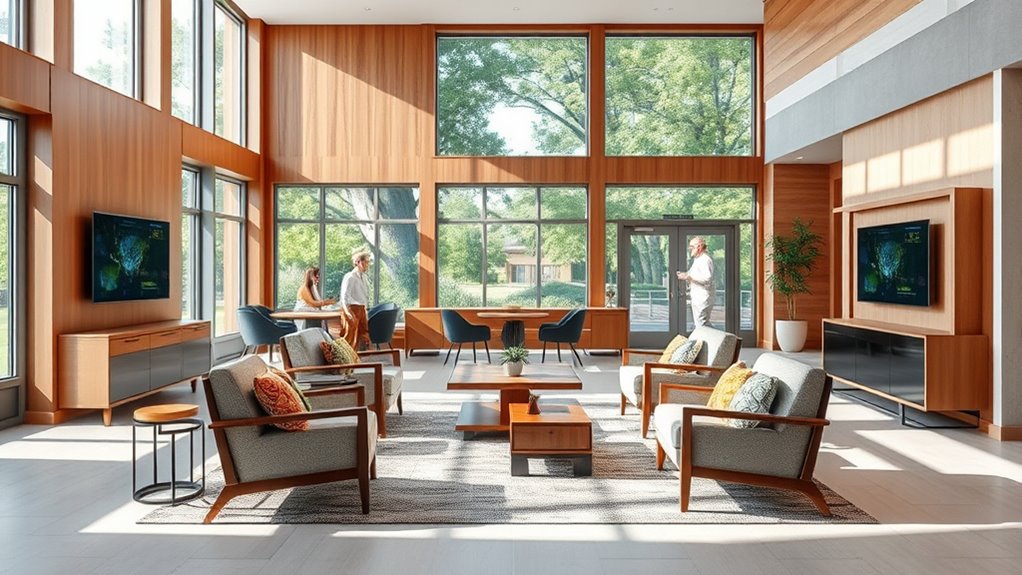
Are you curious about how senior living environments are evolving in 2025? The answer lies in the innovative design trends that prioritize comfort, independence, and well-being. One of the most prominent shifts is the integration of smart home technology. These advanced systems transform living spaces into intuitive, connected environments where residents can control lighting, temperature, security, and even appliances with simple voice commands or mobile apps. It’s not just about convenience; it’s about fostering independence and enhancing safety. For example, motion sensors and automated lighting reduce fall risks, while smart emergency systems ensure help is always just a button away. This technology creates an environment where seniors feel more empowered and secure, giving them greater confidence to manage daily tasks without feeling overwhelmed. smart home technology is becoming a central feature in designing future-ready senior living spaces.
Alongside the smart home revolution, outdoor gardens are becoming a cornerstone of senior living design. These aren’t just aesthetic additions; they’re carefully crafted spaces that promote physical activity, social interaction, and mental health. Imagine stepping into lush, accessible gardens designed with senior needs in mind—raised beds, smooth pathways, and shaded seating areas. These outdoor environments offer residents a peaceful retreat from indoor spaces, encouraging outdoor strolls, gardening, or simply enjoying nature’s calming presence. Access to outdoor gardens helps combat feelings of isolation and provides a essential connection to the natural world, which is proven to improve mood and cognitive function. Developers and designers are now focusing on creating these green sanctuaries that are safe, easy to navigate, and inviting for residents of all mobility levels.
Furthermore, the synergy between smart home technology and outdoor gardens is transforming senior living into a more holistic experience. For example, outdoor lighting can be automated to turn on at sunset, creating a warm and welcoming atmosphere. Sensors might monitor garden conditions or alert staff if a resident needs assistance while outdoors. These innovations make outdoor spaces safer and more accessible, encouraging residents to spend more time outside, which benefits both their physical health and emotional well-being. The trend is moving toward environments that seamlessly blend indoor comfort with outdoor vitality, emphasizing a lifestyle that is active, engaged, and safe. As you look ahead to 2025, it’s clear that senior living design is focusing on creating spaces that are not only functional but also inspiring, nurturing independence, and fostering a genuine sense of community.
Frequently Asked Questions
How Will Technology Integration Shape Senior Living Environments in 2025?
Technology integration will transform senior living environments in 2025 by making daily life more engaging and connected. You’ll see virtual reality offering immersive experiences that promote mental well-being, while AI companions provide personalized support and companionship. These innovations help seniors stay active, socially connected, and independent. As a result, living spaces become smarter, more responsive, and tailored to individual needs, enhancing overall quality of life in ways never before possible.
What Sustainable Materials Are Trending in Senior Living Design?
Think of sustainability as the heartbeat of modern design. You’ll see eco-friendly furnishings becoming more popular, blending style with responsibility. Using renewable resources like bamboo, cork, and reclaimed wood, your space becomes a proof to environmental consciousness. These materials aren’t just trendy; they’re a conscious choice that supports a greener future, ensuring your senior living environment remains both beautiful and sustainable for years to come.
How Do Cultural Preferences Influence Senior Living Design Choices?
You consider how cultural preferences influence senior living design choices by incorporating cultural symbolism and respecting aesthetic preferences. By understanding residents’ backgrounds, you create spaces that feel familiar and welcoming, fostering comfort and connection. This approach guarantees the design reflects their cultural values and traditions, making the environment more personalized and meaningful. Emphasizing cultural symbolism and aesthetic preferences helps you craft senior living spaces that truly resonate with diverse residents.
What Role Does Biophilic Design Play in Enhancing Senior Well-Being?
Imagine waking up to sunlight filtering through lush greenery, feeling a gentle breeze on your skin. Biophilic design connects you to nature, providing sensory stimulation that calms and invigorates. It enhances senior well-being by reducing stress and improving mood. When you incorporate natural elements like plants and sunlight into your living space, you create a nurturing environment that promotes health, happiness, and a strong sense of connection with the world outside.
Will There Be New Safety Features Incorporated Into Future Designs?
You’ll see new safety features in future designs, like smart alarm systems that quickly alert residents and staff during emergencies. These systems improve emergency response times and help prevent accidents. Future layouts will focus on safety, ensuring easier navigation and access to emergency devices. By integrating advanced technology, you’ll feel more secure and supported, knowing that safety is prioritized to protect your well-being at all times.
Conclusion
By embracing these 2025 senior living design trends, you create spaces that truly enhance comfort and community. Some might worry these trends could feel too modern or impersonal, but with thoughtful touches, they foster warm, inviting environments. Remember, innovative design isn’t about losing tradition; it’s about blending comfort with functionality. So, go ahead—incorporate these trends confidently, knowing they’ll help residents feel both cared for and inspired in their daily lives.
